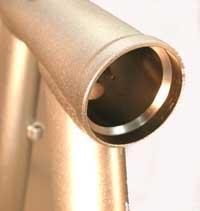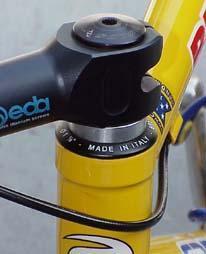

Headset Standards and NomenclatureThe headset of a bicycle allows the fork steering column and front wheel to rotate and turn. There are now several different systems in use on bicycles. The installation and service aspect vary according to the style. This article will review the following headset types: Threaded, Threadless, Zero Stack, Integrated System, Campagnolo Hiddenset, Perdido, Columbus type, and Onepointfive Standard. Adjustment procedures will not be discussed directly, rather the aim is to provide an overview of the different types of headset now used and their structural features. This article was produced with the assistance of Park Tool. Conventional Threaded Headsets
The threaded headset was once the common headset design for most bicycles. The "threaded" in the name refers to the external threading at the top of the fork steering column. Bearing cups are pressed into the bike head tube. The bearings themselves sit above and below the pressed races. The top most bearing-race has internal threading, and is held in place by a threaded locknut. The stem has no effect on the headset adjustment. Threaded headset size are designated by the outer diameter of the steering column. This can seem confusing, because the head cups do not measure the named standard. The threaded standards are 1 inch, 1-1/8 inch, and 1-1/4 inch headsets. The various standards are generally not interchangeable. |
||
|
||
|
 |
Threadless headsets are often referred to as 'Aheadsets', the brand name of the first popular headset of this type, and have many of the same features as threaded headsets. Bearing cups are pressed into the bike headtube. The bearings themselves sit above and below the pressed races. The steering column has no threading. The top race uses an internal centering sleeve on the column to maintain alignment to the bearing cup. Pressure is applied to the top race from the stem, and that pressure is supplied by an adjusting cap and bolt that screws into a nut inside the steerer tube.
Threadless Headsets must use a compatible stem. The stem binds to the outside of the column, and holds the top race in adjustment.
 |
Zero Stack or "Low Profile"
 |
Zero Stack or "low profile" is a relatively new design. This system uses pressed cups that act as a holder for a bearing. The diameter of the headtube and cups allow the bearings to sit flush or even inside the headtube. The diameter of the pressed cups is nominally 44mm. If the model uses cartridge bearings, the cups acts as a bearing holder, and do not take bearing movement or wear directly. The cups may be changed if the user is changing headset brand or model. Less expensive models do use a cup and cone bearing system similar to conventional headsets, with retainer ball bearings.
The headset is adjusted in a similar fashion as Threadless Headsets. Pressure is applied from an adjusting cap and bolt in the stem. The Zero Stack-type headsets do have some stack height, inspite of their name.
 |
Integrated Systems without cups
 |
 |
The Integrated System uses cartridge bearings that are supported by machining in a specially shaped head tube. There are no pressed cups into the frame, rather, the frame headtube has "cups" machined directly into it. A cartridge bearing slips into place, and is simply lifted out for replacement. The common bearing is 41mm outside diameter, and has a bevel of 45 degrees that faces the frame. There are frames with a 36 degree bevel and use a 36 degree bearing.
Adjustment is similar to a conventional threadless headset. Pressure is applied from an adjusting cap and bolt in the stem. The name Integrated System is not a registered trade name and refers to these headsets requiring an internally machined headtube, with a bearing diameter of nominally 41mm.
 |
The image on the left shows the inside of the specially designed and machined headtube. The inside bevel acts as the bearing "cup". Cartridge bearing are used which drop directly into the headtube as a slip fit. There is no pressing involved. Adjustment is similar to a conventional threadless headset.
 |
 |
Campagnolo® Hiddenset
 |
The Campagnolo® Hiddenset is proprietary design. The frame must be
compatible with this design for this headset to be used. The bearings
cone races do not press into the frame. The frame has a specially machined
headtube, however, this standard is not interchangeable with the Integrated
System described above. Adjustment is similar to a conventional threadless
headset.
Perdido®
 |
The Perdido® headset should not be considered an Integrated System, nor a Zero Stack. The system uses pressed cups into the frame headtube. The bearings are fitted into the cups, and are not a simple slip fit like Integrated System and Zero Stack. The Perdido® standard requires a very specific headtube inside diameter. The outside diameter of the Perdido® pressed race is 44.5mm, and the recommended inside diameter of the head tube is 44.4mm. The Zero Stack pressed cups use a 44mm OD. This means a Zero Stack is not directly compatible with the Perdido® system.
In some cases, it may be possible to ream a Zero Stack compatible frame up to the 44.4mm ID. The Perdido® also requires the machining be deep. Before considering Perdido® check that the frame will not be compromised by this reaming. The Perdido headset is adjusted like a coventional threadless headsets.
Perdido® is a registered name. For specifications on Perdido® see Perdido®.
Columbus® Type Headset
 |
The Columbus type headset uses a cartridge bearing holding-cup that is pressed into the frame. The frame has no special seat machined inside the headtube. The bearings sit above and below the frame. The bearings are nominally 41.5mm outside diameter and slip into the cups. This headset allows the appearance of an Integrated System or Zero-Stack by matching the headtube diameter with the cup outside diameter. The Columbus type headsets are not interchangeable with other types. Cups are typically painted with the frame which assists to hide their appearance. Adjustment is similar to a conventional threadless headset.
 |
Onepointfive Standard®
 |
The Onepointfive Standard¨ uses a 1.5-inch diameter steering column. The headtube inside diameter is nominally two inches (50mm). The headsets are conventional threadless types, and are quite large. The adjustment procedure is the same as a threadless headset. Left is a frame cup from the Onepointfive standard next to a 1-1/8-inch standard frame cup.
For more on the Onepointfive see www.onepointfivestandard.com



